Lock picking, a skill shrouded in secrecy and curiosity, can be an invaluable tool for homeowners. Mastering the art of residential lock picking opens up a world of possibilities, allowing us to regain access to our homes when keys are misplaced or forgotten.
But how does one begin this journey into the realm of lock manipulation? In this discussion, we will explore essential tips that equip homeowners with the knowledge and techniques needed to conquer even the trickiest of locks.
So, whether you've found yourself locked out or simply wish to expand your repertoire of practical skills, let us uncover the secrets behind mastering residential lock picking.
Understanding Residential Lock Types

When it comes to understanding residential lock types, we need to familiarize ourselves with the various mechanisms and components that make up these essential security features.
One important aspect to consider is the residential lock installation process. Different locks require different methods of installation, and it's crucial to ensure that the lock is properly installed to maximize its effectiveness in securing your home.
Another crucial aspect of understanding residential lock types is being aware of common lock vulnerabilities. Despite advancements in lock technology, there are still vulnerabilities that can be exploited by potential intruders. One common vulnerability is lock bumping, which involves using a special bump key to manipulate the pins inside the lock and gain unauthorized access. To mitigate this vulnerability, homeowners can consider installing bump-resistant locks or using additional security measures such as security pins or electronic locks.
Additionally, it's important to understand the different types of residential locks available in the market. The most common types include deadbolts, knob locks, lever handle locks, and electronic locks. Each type has its own advantages and disadvantages, and choosing the right one for your home depends on factors such as security needs, budget, and personal preference.
Essential Tools for Lock Picking
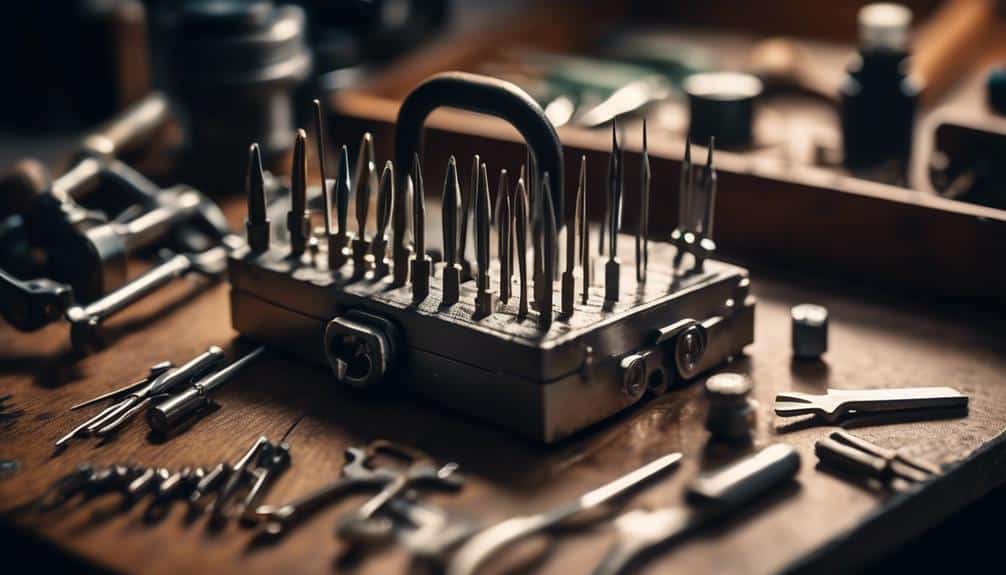
When it comes to lock picking, having the right tools is essential. In order to successfully pick locks, we need to have the must-have lock picking tools at our disposal.
However, it isn't just about having the tools, but also about choosing the right ones for the job.
Additionally, we must remember to maintain our tools to ensure their effectiveness and longevity.
Must-Have Lock Picking Tools
To effectively engage in lock picking, it is essential to possess a selection of must-have tools specifically designed for this purpose. These tools will help increase your chances of successfully picking a lock and can be invaluable in emergency situations. Here are some essential lock picking tools that every homeowner should have:
| Tool Name | Description | Function |
|---|---|---|
| Tension Wrench | A flat, L-shaped tool for applying rotational force | Applies tension to the lock cylinder while picking the lock |
| Hook Pick | A thin, curved tool with a pointed end | Used to manipulate the pins inside the lock and set them correctly |
| Rake Pick | A flat tool with multiple jagged edges | Designed to quickly manipulate the pins inside the lock |
These tools are commonly used by professional locksmiths and enthusiasts alike. By having these must-have lock picking tools at your disposal, you can better prepare for unexpected emergencies or gain access to your property in case of a lockout situation.
Choosing the Right Tools
After understanding the must-have lock picking tools, it's important to choose the right tools for effectively engaging in lock picking.
When it comes to choosing the right lock pick set, there are a few tips that beginners in lock picking should keep in mind.
Firstly, opt for a set that includes a variety of picks, such as hooks, diamonds, and rakes, as this will allow you to tackle different types of locks. Additionally, consider the material of the picks, with stainless steel being a popular choice due to its durability.
It's also advisable to choose a set that comes with a transparent practice lock, as this will help you develop your lock picking skills.
Maintaining Your Tools
Proper maintenance of your lock picking tools is essential for ensuring their longevity and optimal performance.
To maintain tool longevity, it's important to regularly clean and lubricate your tools. Cleaning your tools after every use helps remove any debris or dirt that may have accumulated during the lock picking process. A simple wipe down with a clean cloth or a gentle brush can effectively remove these particles.
Lubricating your tools is equally important, as it helps reduce friction and prevents rust or corrosion. Applying a small amount of lubricant, such as graphite powder or silicone spray, to the moving parts of your tools will keep them operating smoothly.
Basic Techniques for Lock Manipulation
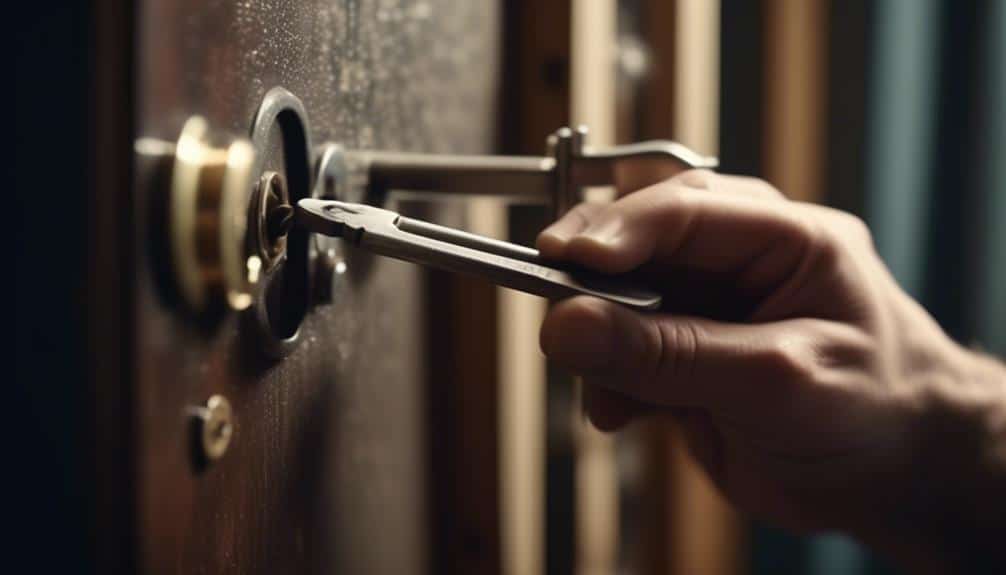
One effective technique for manipulating locks is by employing a tension wrench and a lock pick. The tension wrench is used to apply slight pressure to the lock's core, while the lock pick is used to manipulate the lock's pins. Here are some basic lock manipulation techniques that can be used by homeowners:
| Technique | Description | Tools Required |
|---|---|---|
| Single Pin Picking | This technique involves manipulating each pin in the lock individually | Tension wrench, hook pick |
| Raking | Raking involves quickly moving the lock pick up and down to set the pins | Tension wrench, rake pick |
| Bumping | Bumping is a technique that uses a specially designed bump key | Bump key, tension wrench |
| Jiggling | Jiggling involves applying varying degrees of pressure while rotating | Tension wrench, half-diamond or snake rake pick |
| Rocking | Rocking involves applying upward and downward pressure simultaneously | Tension wrench, rake pick or diamond pick |
It is essential to practice these techniques responsibly and only on locks that you have permission to manipulate. Additionally, it is crucial to have a thorough understanding of lock picking laws and regulations in your area. Remember, the primary purpose of learning these techniques is to enhance your home security knowledge and protect yourself from potential break-ins.
Advanced Methods for Picking High-Security Locks
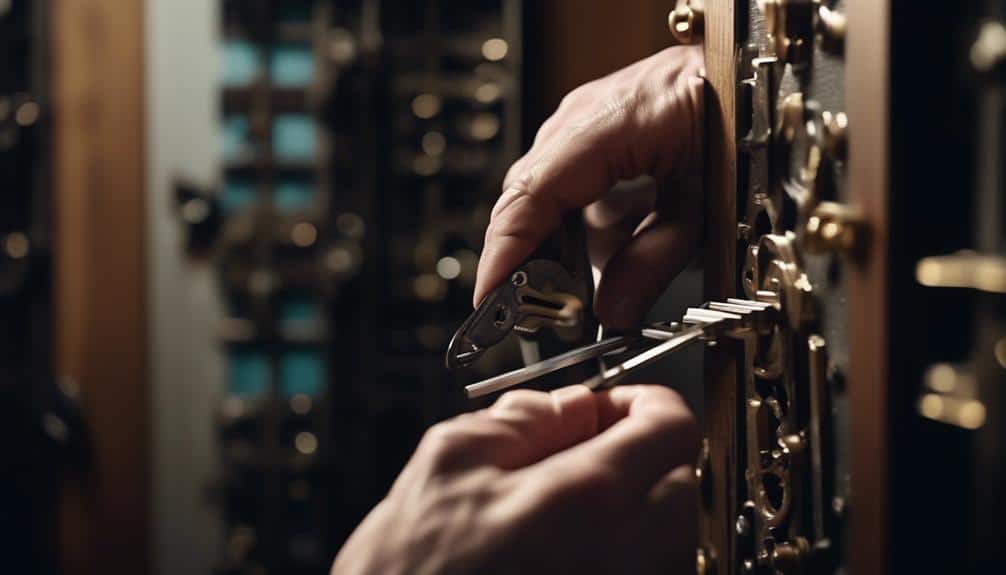
When it comes to picking high-security locks, specialized tools are essential.
Understanding the intricacies of lock mechanisms is crucial for successful manipulation.
In this discussion, we'll explore advanced techniques that require precision and finesse to overcome the challenges posed by high-security locks.
Specialized Tools for High-Security Locks
To effectively pick high-security locks, it's beneficial to utilize specialized tools designed specifically for this purpose.
These tools are essential for picking master locks and bypassing lock cylinders with advanced security features.
One such tool is the bypass tool, which is designed to manipulate the lock's internal components and disengage the locking mechanism. Bypass tools often come in various shapes and sizes, depending on the specific lock type and security level.
Another useful tool is the pick gun, which uses rapid vibrations to mimic the action of a traditional lock pick. This tool can quickly and efficiently manipulate the lock pins, allowing for faster and more precise lock picking.
Additionally, specialized tension wrenches are crucial for applying the right amount of pressure on the lock, ensuring a successful pick.
These specialized tools are essential for homeowners looking to master the art of picking high-security locks.
Understanding Lock Mechanisms
Understanding the intricacies of lock mechanisms is crucial for those seeking to employ advanced methods in picking high-security locks. To effectively navigate these complex systems, it's important to be aware of common lock vulnerabilities and use appropriate lock picking techniques. Here are three key points to consider:
- Pin Tumbler Locks: This is the most common type of lock mechanism found in residential settings. It consists of a series of pins that must be aligned at the shear line to unlock the cylinder. Understanding how these pins interact and manipulating them with precision is essential for successful lock picking.
- Wafer Locks: These locks use thin wafers instead of pins. They're typically found in older locks or low-security applications. To pick wafer locks, one must exert pressure on the pins while manipulating the wafers to align them and release the lock.
- Disc Detainer Locks: These locks utilize a series of rotating discs with notches that must be aligned to unlock the mechanism. Picking disc detainer locks requires specialized tools and techniques to manipulate the discs into the correct positions.
Techniques for Precision Picking
Having a thorough understanding of lock mechanisms is essential when employing advanced techniques for picking high-security locks in residential settings. Precision picking techniques require a careful and deliberate approach to manipulate the lock components with precision and finesse.
One such technique is known as 'single pin picking,' where each pin is manipulated individually until all pins align and the lock can be turned.
Another technique is 'raking,' which involves using a specially-designed tool to rapidly manipulate multiple pins simultaneously.
Advanced lock manipulation techniques also include methods such as 'bumping' and 'impressioning,' which exploit the characteristics of certain lock types to gain access without the original key.
These techniques require practice, patience, and a deep understanding of lock mechanisms to ensure successful and non-destructive entry.
Troubleshooting Common Lock Picking Challenges
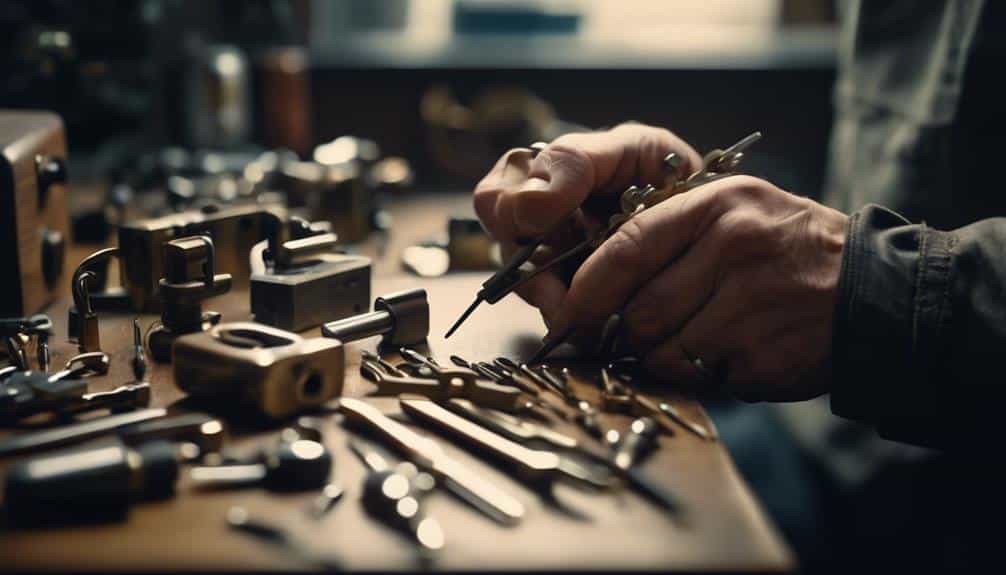
When encountering common lock picking challenges, it's essential to approach troubleshooting with a systematic and methodical mindset. To help you overcome these hurdles and avoid lock picking mishaps, here are three important tips:
- Assess the Lock:
Before attempting to pick a lock, carefully examine its condition. Look for any signs of damage, such as rust or misalignment, which can hinder the picking process. If the lock seems compromised or excessively worn, consider contacting a professional locksmith for assistance.
- Use the Correct Tools:
Using the right tools is crucial for successful lock picking. Ensure that you have a variety of picks and tension wrenches suitable for different lock types. Using improper tools can cause damage to the lock or make picking more challenging than necessary.
- Practice Proper Technique:
One common mistake in lock picking is applying excessive force or tension to the lock. Remember to use light and controlled pressure when manipulating the pins. Additionally, maintain a steady hand and avoid rushing the process. With practice, you'll develop the finesse and skill needed for efficient lock picking.
Preventing Damage While Picking a Lock
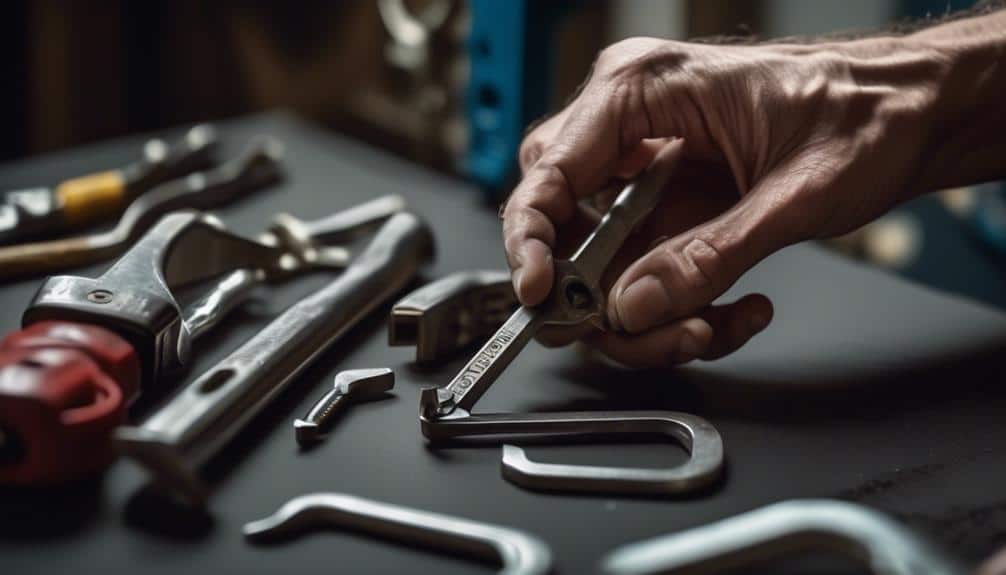
What measures can be taken to minimize damage when picking a lock?
When picking a lock, it's important to take precautions to prevent any unnecessary damage. By following a few simple steps, you can minimize the risks associated with lock picking and protect the integrity of the lock.
Firstly, it's crucial to use the right tools for the job. Using a high-quality lock pick set that's designed for residential locks will help prevent damage. Cheap or improper tools can easily damage the lock mechanism, leading to expensive repairs.
Additionally, applying the correct amount of pressure is essential. Too much force can cause the lock pins to break or become misaligned, while too little pressure can result in ineffective picking. Finding the right balance is key to minimizing the risk of lock damage.
Another important aspect is to avoid excessive twisting or turning of the lock pick. Applying too much torque can cause the lock to jam or break, making it more difficult to fix. Gentle and controlled movements are crucial to prevent any unnecessary strain on the lock.
Lastly, it's crucial to practice patience and avoid rushing the process. Rushing can lead to mistakes, such as breaking a pick inside the lock or damaging the lock mechanism. Taking your time and being methodical in your approach will help minimize the risks of lock damage.
Legal and Ethical Considerations in Lock Picking

To ensure the responsible and ethical practice of lock picking, it's important to understand the legal implications and ethical considerations associated with this skill. Here are three key points to consider:
- Legal Implications: It's crucial to understand the laws and regulations regarding lock picking in your jurisdiction. Lock picking can be considered illegal if done without proper authorization or for malicious purposes. Engaging in lock picking without the necessary legal authority can lead to criminal charges and penalties. It's essential to familiarize yourself with local laws and obtain the appropriate permissions or certifications if required.
- Ethical Considerations: Lock picking is a skill that can be used for both legal and illegal purposes. It's important to approach lock picking with a strong ethical framework. Consider the potential consequences of your actions and the impact they may have on others. It's crucial to use lock picking responsibly and only in situations where you have the legal right or permission to do so.
- Responsible Practice: Lock picking should only be used for legitimate purposes such as gaining access to your own property or assisting others who've authorized you to help them. Always obtain proper consent before attempting to pick a lock. Additionally, it's important to continuously educate yourself on the latest ethical guidelines and legal requirements pertaining to lock picking.
Resources for Furthering Your Lock Picking Skills
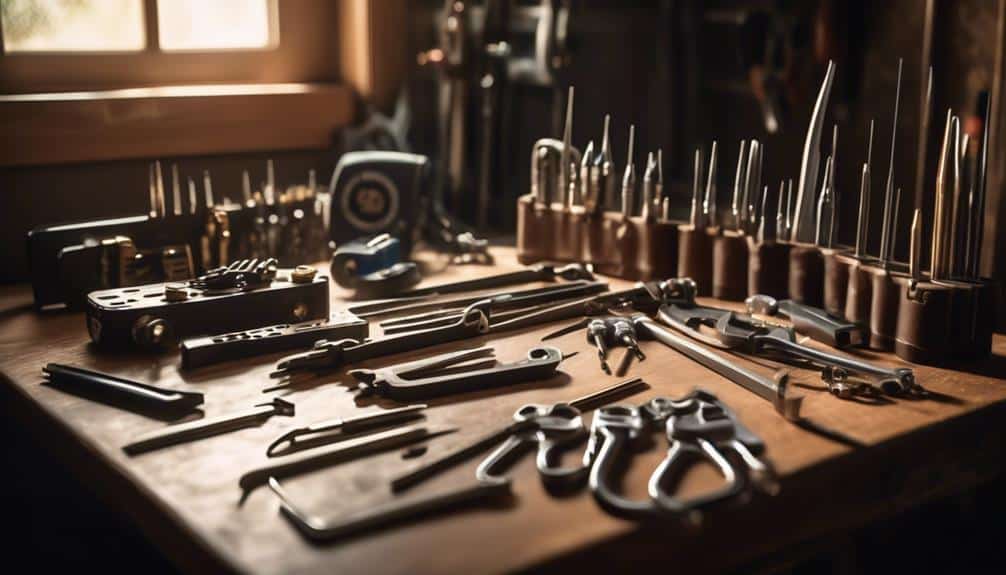
For those looking to enhance their lock picking skills, a variety of resources are available to provide valuable guidance and instruction. Whether you are a beginner or an experienced lock picker, these resources can help you practice and improve your lock picking skills. One of the most accessible resources for practicing lock picking is online lock picking communities. These communities provide a platform for lock pickers to share their knowledge, experiences, and techniques. They often have forums where members can ask questions, seek advice, and engage in discussions about lock picking. Additionally, many online lock picking communities offer tutorials, videos, and guides that can help you learn new techniques and improve your skills.
Here is a table highlighting some popular online lock picking resources:
| Resource | Description | Website |
|---|---|---|
| Lock Picking Subreddit | A community of lock pickers sharing tips, techniques, and resources. | www.reddit.com/r/lockpicking |
| The Lock Lab | A YouTube channel featuring lock picking tutorials, demonstrations, and reviews. | www.youtube.com/thelocklab |
| Lock Picking 101 | An online forum and resource hub for lock pickers of all skill levels. | www.lockpicking101.com |
Frequently Asked Questions
Can I Use Lock Picking Techniques on Any Type of Lock, Regardless of Its Security Level?
Yes, different lock picking techniques are required for different types of locks, regardless of their security level. It's essential to understand the specific mechanisms and vulnerabilities of each lock in order to successfully pick it.
However, we strongly advise against attempting lock picking without proper training and certification. Professional locksmiths play a crucial role in ensuring home security by providing expert services and advice on the best lock systems for your specific needs.
What Are Some Common Mistakes to Avoid When Picking a Lock?
When it comes to picking locks, we've all made our fair share of mistakes. Beginners often stumble upon common errors that can make or break their lock-picking experience.
From using too much force to not properly aligning the pins, these slip-ups can lead to frustration and even damage to the lock or door.
But fear not, with a few tips and techniques, you can avoid these pitfalls and become a master at picking locks without causing any harm.
Is It Possible to Pick a Lock Without Any Specialized Tools?
Yes, it's possible to pick a lock without any specialized tools. Lock picking techniques using household items, such as bobby pins or paperclips, can be employed. However, it's important to note the potential risks and consequences of attempting to pick a lock without proper tools.
This can lead to damage to the lock or door, and even legal ramifications in some cases. Therefore, it's recommended to seek professional assistance when dealing with lock-related issues.
Can Lock Picking Cause Any Damage to the Lock or Door?
Lock picking can indeed cause damage to both the lock and the door if not done correctly. Applying excessive force or using improper tools can result in broken pins, bent mechanisms, or even damage to the door frame.
To prevent this, it's essential to use the right tools and techniques. By applying gentle pressure and using precision tools, homeowners can minimize the risk of damaging their locks or doors while attempting to pick them.
Are There Any Legal Implications or Ethical Considerations to Be Aware of When Learning and Practicing Lock Picking?
When learning and practicing lock picking, it's important to be aware of the legal implications and ethical considerations involved.
Engaging in lock picking without proper authorization can be illegal and may result in criminal charges.
Additionally, it's essential to consider the ethical implications of picking locks, as it involves accessing someone's private property without their consent.
It's crucial to always act responsibly and ethically when learning and practicing lock picking techniques.


